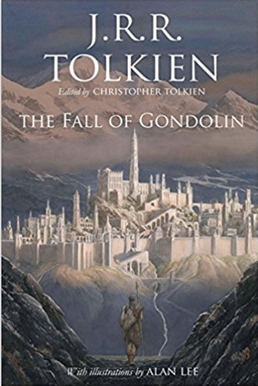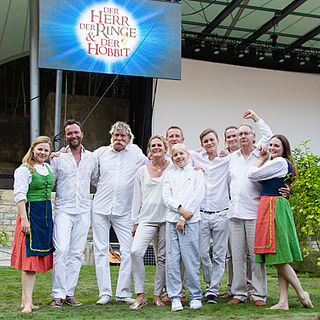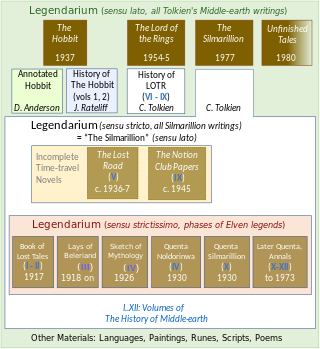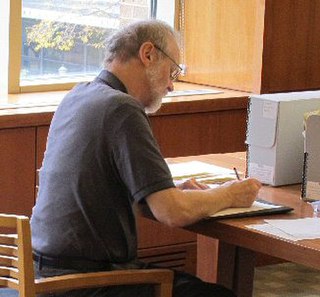Related Research Articles
In J. R. R. Tolkien's fictional legendarium, Beleriand was a region in northwestern Middle-earth during the First Age. Events in Beleriand are described chiefly in his work The Silmarillion, which tells the story of the early ages of Middle-earth in a style similar to the epic hero tales of Nordic literature, with a pervasive sense of doom over the character's actions. Beleriand also appears in the works The Book of Lost Tales, The Children of Húrin, and in the epic poems of The Lays of Beleriand.
Unfinished Tales of Númenor and Middle-earth is a collection of stories and essays by J. R. R. Tolkien that were never completed during his lifetime, but were edited by his son Christopher Tolkien and published in 1980. Many of the tales within are retold in The Silmarillion, albeit in modified forms; the work also contains a summary of the events of The Lord of the Rings told from a less personal perspective.

Thomas Alan Shippey is a British medievalist, a retired scholar of Middle and Old English literature as well as of modern fantasy and science fiction. He is considered one of the world's leading academic experts on the works of J. R. R. Tolkien about whom he has written several books and many scholarly papers. His book The Road to Middle-Earth has been called "the single best thing written on Tolkien".

The Atlas of Middle-earth by Karen Wynn Fonstad is an atlas of J. R. R. Tolkien's fictional realm of Middle-earth. It was published in 1981, following Tolkien's major works The Hobbit, The Lord of the Rings, and The Silmarillion. It provides many maps at different levels of detail, from whole lands to cities and individual buildings, and of major events like the Battle of the Pelennor Fields. The maps are grouped by period, namely the First, Second, and Third Ages of Middle-earth, with chapters on The Hobbit and The Lord of the Rings. A final chapter looks at geographic themes such as climate, vegetation, population, and languages around Middle-earth.
Trolls are fictional characters in J. R. R. Tolkien's Middle-earth, and feature in films and games adapted from his novels. They are portrayed as monstrously large humanoids of great strength and poor intellect. In The Hobbit, like the dwarf Alviss of Norse mythology, they must be below ground before dawn or turn to stone, whereas in The Lord of the Rings they are able to face daylight.

J. R. R. Tolkien's The Fall of Gondolin is one of the stories which formed the basis for a section in his posthumously-published work The Silmarillion, with a version later appearing in The Book of Lost Tales. In the narrative, Gondolin was founded by King Turgon in the First Age; the city was carefully hidden, enduring for centuries before being betrayed and destroyed.

The Tolkien Ensemble is a Danish ensemble which created "the world's first complete musical interpretation of the poems and songs from The Lord of the Rings". They published four CDs from 1997 to 2005, in which all the poems and songs of The Lord of the Rings are set to music. The project was approved by the Tolkien Estate. Queen Margrethe II of Denmark gave permission to use her illustrations on the CD covers.

Tolkien's legendarium is the body of J. R. R. Tolkien's mythopoeic writing, unpublished in his lifetime, that forms the background to his The Lord of the Rings, and which his son Christopher summarized in his compilation of The Silmarillion and documented in his 12-volume series The History of Middle-earth. The legendarium's origins reach back to 1914, when Tolkien began writing poems and story sketches, drawing maps, and inventing languages and names as a private project to create a unique English mythology. The earliest story drafts are from 1916; he revised and rewrote these for most of his adult life.

The Lord of the Rings: A Reader's Companion (2005) is a nonfiction book by the scholars Wayne G. Hammond and Christina Scull. It is an annotated reference to J. R. R. Tolkien's heroic romance, The Lord of the Rings.
Verlyn Flieger is an author, editor, and Professor Emerita in the Department of English at the University of Maryland at College Park, where she taught courses in comparative mythology, medieval literature, and the works of J. R. R. Tolkien. She is well known as a Tolkien scholar, especially for her books Splintered Light and A Question of Time. She has won the Mythopoeic Scholarship Award four times for her work on Tolkien's Middle-earth writings.

The History of The Hobbit is a two-volume study of J. R. R. Tolkien's 1937 children's fantasy novel The Hobbit. It was first published by HarperCollins in 2007. It contains Tolkien's unpublished drafts of the novel, with commentary by John D. Rateliff. It details Tolkien's various revisions to The Hobbit, including abandoned revisions for the unpublished third edition of the work, intended for 1960, as well as previously unpublished original maps and illustrations drawn by Tolkien.

Middle-earth is the setting of much of the English writer J. R. R. Tolkien's fantasy. The term is equivalent to the Miðgarðr of Norse mythology and Middangeard in Old English works, including Beowulf. Middle-earth is the human-inhabited world, that is, the central continent of the Earth, in Tolkien's imagined mythological past. Tolkien's most widely read works, The Hobbit and The Lord of the Rings, are set entirely in Middle-earth. "Middle-earth" has also become a short-hand term for Tolkien's legendarium, his large body of fantasy writings, and for the entirety of his fictional world.

The Letters of J. R. R. Tolkien is a selection of the philologist and fantasy author J. R. R. Tolkien's letters. It was published in 1981, edited by Tolkien's biographer Humphrey Carpenter, who was assisted by Christopher Tolkien. The selection, from a large mass of materials, contains 354 letters. These were written between October 1914, when Tolkien was an undergraduate at Oxford, and 29 August 1973, four days before his death. The letters are of interest both for what they show of Tolkien's life and for his interpretations of his Middle-earth writings.

A Companion to J. R. R. Tolkien is a 2014 book edited by Stuart D. Lee and published by Wiley-Blackwell. It is a part of the Blackwell Companions to Literature series, which have been described as prestigious reference works, and features authors well-known in the field of Tolkien studies.

Tolkien's artwork was a key element of his creativity from the time when he began to write fiction. The philologist and author J. R. R. Tolkien prepared a wide variety of materials to support his fiction, including illustrations for his Middle-earth fantasy books, facsimile artefacts, more or less "picturesque" maps, calligraphy, and sketches and paintings from life. Some of his artworks combined several of these elements.
J. R. R. Tolkien's Middle-earth fantasy writings have often been accused of embodying outmoded attitudes to race. However, scholars have noted that he was influenced by Victorian attitudes to race and to a literary tradition of monsters, and that he was anti-racist both in peacetime and during the two World Wars.

Richard Carroll West was an American librarian and one of the first Tolkien scholars. He is best known for his 1975 essay on the interlace structure of The Lord of the Rings, for which he won the 1976 Mythopoeic Scholarship Award for Inkling Studies.
Gergely Nagy is a Hungarian medievalist and Tolkien scholar.

The music of Middle-earth consists of the music mentioned by J. R. R. Tolkien in his Middle-earth books, the music written by other artists to accompany performances of his work, whether individual songs or adaptations of his books for theatre, film, radio, and games, and music more generally inspired by his books.

The Worlds of J. R. R. Tolkien: The Places that Inspired Middle-earth is a 2020 non-fiction book by the journalist and Tolkien scholar John Garth. It describes the places that most likely inspired J. R. R. Tolkien to invent Middle-earth, as portrayed in his fantasy books The Hobbit and The Lord of the Rings. Those places include many that Tolkien lived in or visited in his early life, as well as sites from history and literature. Most are real, for instance with England as the counterpart of the Shire, though some, like Atlantis, are mythical, and others, like Mirkwood, probably have roots in real places. He notes the ambiguities in some of the connections, and that others have made superficial comparisons, such as of Tolkien's towers with various modern towers in Birmingham, where Tolkien lived as a child. Garth presents his theories of the likely origins of some of these places, supporting these with maps and photographs.
References
- ↑ "Chris Snyder". Marymount University. Archived from the original on 21 December 2015. Retrieved 5 December 2010.
- ↑ Clark, Rhodri (November 18, 2003). "Anglo-Saxon spin halted to credit Welsh". WalesOnline. Retrieved 5 December 2010.
- ↑ Bratman, David (2014). "The Making of Middle-earth: A New Look Inside the World of J.R.R. Tolkien by Christopher Snyder, and: The Essential Tolkien Trivia and Quiz Book: A Middle-earth Miscellany by William MacKay". Tolkien Studies. 11 (1): 254–257. doi:10.1353/tks.2014.0007. ISSN 1547-3163. S2CID 170373518.
- ↑ Marshall, David W. (2014). "The Making of Middle-earth: A New Look Inside the World of J.R.R. Tolkien by Christopher Snyder". Arthuriana. 24 (4): 149–151. doi:10.1353/art.2014.0056. ISSN 1934-1539. S2CID 161712168.
- ↑ DiGirolamo, Kate (13 December 2013). "[Review] The Making of Middle-earth: A New Look Inside the World of J.R.R. Tolkien". Library Journal . Retrieved 14 February 2021.